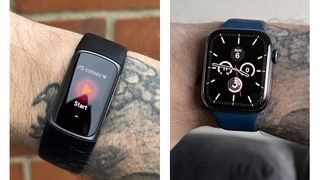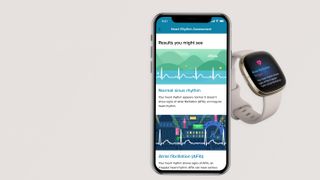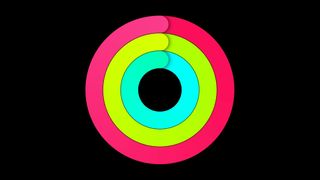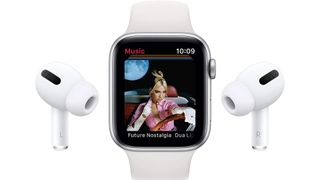Fitbit vs Apple Watch: Which fitness tracker is better?
It’s time to settle the Fitbit vs Apple Watch debate.

When choosing a new fitness tracker, the decision often boils down to one key contest: Fitbit vs Apple Watch. The two mammoth brands have been at the top of the tracker game for years and, though the likes of Garmin and Whoop also boast some of the best fitness trackers on the market, the pair remain two of the biggest names in the wearable space.
But, with many people looking to upgrade, which one should you pick to take pride of place on your wrist? Unfortunately, there’s no simple answer to that question. Instead, you have to consider your health and fitness goals, what you plan to use the tracker for, and the metrics you value most to determine which brand wins.
Not only this, but you’ve also got to pick which Fitbit or Apple Watch you want, with different models and generations offering varying degrees of detail in their health and fitness feedback (not to mention catering to a range of budgets).
To help you make your mind up, we’ve considered the features, workout-tracking credentials, design and battery life of the Fitbit and Apple Watch models available to deliver a final verdict on which one wins this high-tech battle royal. So, read on to find out which brand is right for you.
Fitbit vs Apple Watch: What models are available?
There is a huge range of Fitbit fitness trackers and smartwatches available, from the sports-focused Fitbit Charge 5 to the all-singing Fitbit Sense. Apple offers slightly fewer models – the SE, 3, 4, 5, 6, Apple Watch Series 7, Apple Watch Series 8, and the newest Apple Watch Series 9.
While all of the models in Apple's range have the same squarish, chunky look, you'll find more variety among Fitbit's catalogue of models. Some, like the Charge 5 above and the newer Charge 6, are thin, discreet bands, while others like the Sense and Sense 2 have larger, square-shaped clock faces more reminiscent of the Apple Watch.
Wearables analyst Leo Gebbie from CCS Insight told Live Science that, historically, Fitbit and Apple targeted different areas of the fitness market.
"The Apple Watch was positioned as an exclusive premium-tier device offering a powerful user interface and third-party app support, whereas Fitbit offered a range of more affordable fitness trackers and smartwatches backed up by a well-established brand," he said.
"However, Apple has diversified its offering over time, bringing older models of the Watch down the price curve to compete directly with Fitbit smartwatches."
One of the main differences between Fitbit and Apple Watch is the latter’s close relationship to the rest of the Apple ecosystem. You need an iPhone to activate the Watch, and it is integrated with Apple’s other devices and services to provide an excellent user experience. By contrast, Fitbit devices are compatible with all smartphones, and simply require the Fitbit smartphone app for connection, making them easily accessible.
It's also worth pointing out that Fitbit models are a lot cheaper — some of the best budget fitness trackers are Fitbit designs. Apple's wearables tend to cost a little more.

Fitbit vs Apple Watch: Which has more smartwatch features?
This one is a win for Apple, which boasts more smart features than its fitness tracking companion. However, Fitbit is quickly catching up with its ever-growing range of services.
An Apple Watch offers notifications, alarms, timers, the Siri personal assistant and a huge app store. Fitbit, on the other hand, has mostly basic services like notification mirroring, and a smaller app offering. You can use your Watch to make payments through Apple Pay, while only some of the Fitbit models — Sense 2, Sense, Versa 4, Versa 3, Versa 2, Versa, Ionic, Charge 3 Special Edition, Charge 4, Charge 5, and Charge 6 — allow payment via Fitbit Pay.
However, all Fitbit models released after November 2022 use Google Pay instead of Fitbit Pay, making them more accessible for contactless payments. These include Versa 4, Sense 2, and Charge 6, and any additional Fitbit devices in the future.
Both Apple and Fitbit offer models with cellular capabilities, meaning you can accept calls and texts from your wrist, without your smartphone. However, while most Apple Watch models can act as an extension to your phone, only a handful of Fitbit devices can do the same — these include Fitbit Sense, Fitbit Sense 2, Fitbit Versa 3, and Fitbit Versa 4.
The Apple Watch Series 8 also has a temperature sensor that can be used for ovulation tracking, and an advanced gyroscope for fall detection. The newer Fitbit models, namely Sense, Sense 2, Charge 5, and Charge 6, are also equipped with a temperature sensor, while only Fitbit Versa and Fitbit Sense come with a gyroscope.
The companies have slightly different approaches to music. With Apple, you can download albums on your watch from the likes of Apple Music and Spotify. On Fitbit, the only way you can download music is if you do so via Deezer or Pandora. It's not a huge issue if you prefer to store music on your phone, but it does give Apple the edge in this category.

Fitbit vs Apple Watch: Which is better for tracking workouts?
Both Fitbit and Apple Watch can track workouts. However, depending on the actual device you're using, they will do this in very different ways, says Gebbie.
"For example, any device from either company can detect when a user is active and record metrics like heart rate and calories burned to review afterwards. But when it comes to specific forms of exercise, there are some differences.
"If you want to go for a run, you’ll be best served by a wearable with GPS onboard to get the most accurate tracking of your movement. All Apple Watches include this, whereas not all Fitbits do."
Owning an Apple Watch allows access to Fitness+, which provides hundreds of instructor-led home workouts including HIIT (high-intensity interval training) sessions, yoga and spinning classes on your iPhone, iPad and Apple TV — but this requires an extra subscription. Similarly, you can get workout classes from Fitbit too, but only if you subscribe to Fitbit Premium.
When it comes to goal-setting features, however, Fitbit easily outshines Apple. Fitbit devices allow you to set specific goals for many different metrics, including steps, distance, Active Zone Minutes, floors climbed and calories burned, while the Apple Watch only lets you set a goal for calorie burn. If weight loss is not your priority, you are likely to be disappointed by this limited functionality.

Fitbit vs Apple Watch: Which one has more features?
Both Apple Watch and Fitbit models are packed with health and fitness features to monitor heart rate, steps, calories burned, sleep and workouts.
All Apple Watches have built-in GPS, while only some Fitbits do. Similarly, some (but not all) Fitbit models and Apple Watches have blood oxygen tracking capabilities. The higher-end Fitbits with GPS and the Apple Watch Series 7, 8, and 9 all do, while the SE and 3 Watch don’t. Some of the Fitbit and Apple devices can also provide ECG readings, allowing you to monitor heart health. These include the Fitbit Sense, Sense 2, Charge 5, and Charge 6, and the Apple Watch Series 7, 8, and 9.
Gebbie also highlights that "the top-of-the-range Fitbit Sense smartwatch packs some new sensors, which are less common across the wearables landscape, such as an electrodermal activity (EDA) sensor which analyses a wearer’s sweat levels to check for signs of stress."
Both brands offer motivational prompts in different forms. Below, you can see the Apple Ring system, which encourages you to move about during the day, while Fitbit has an Active Zone Minutes scheme (which recommends 150 minutes per week spent in your targeted heart rate zone).

You can also use your Fitbit or Apple Watch to boost your wellbeing. The Apple Watch has a pre-loaded Breathe app, while the Fitbit Sense is equipped with an electrodermal (EDA) sensor that measures the perspiration of your hands, a known indicator of stress. The Fitbit app also has meditation tools included.
Also, both brands offer devices with sleep-tracking features. When you wear the Apple Watch to bed, it will estimate the overall length of your sleep, as well as the time you spend in each sleep stage. The Watch also allows you to create multiple sleep schedules and monitor your sleep trends over the past two weeks. Fitbit offers a similar service, but it narrowly wins this contest by providing more sleep stats and insights like a Personalized Sleep Score.
One of our favorite features on Apple Watch is that, if you start a workout but forget to log it, you will get a prompt asking if you want to turn on tracking.
Even more impressive, the Apple Watches 7, 8, and 9 use specialist AI software to recognize the type of movement you’re doing. For example, rather than simply track that you are dancing, they can distinguish that you are Bhangra dancing – and give a more accurate calorie count as a result.

Fitbit vs Apple Watch: Which design is better?
With its square design, the Apple Watch has hardly changed since it launched in 2015. The Series 8 and 9 have the biggest and toughest screens to date (41mm and 45mm), while the display in the Series 9 is also the brightest.
The Fitbit started out as an activity band-type design and a lot of its models still stick with this aesthetic. The Inspire 2, Charge 5 and Luxe models are all slim trackers, while the Versa 3, Versa 4 and the Sense 2 have a larger, square face.
Both Apple Watches and Fitbits are swim-proof and can be personalized by changing bands or watch faces.
Which look you prefer is down to you, although in our experience the slimmer designs are easier to wear during the night, so they may be preferable for sleep tracking.

Fitbit vs Apple Watch: Which has better battery life?
When it comes to battery life, Fitbit wins hands down, said Gebbie. "The Apple Watch offers an 18-hour battery life, which means you need to charge it every day, whereas many Fitbit trackers and watches can last for days or even weeks at a time without charging.
"This simplicity and reliability is attractive to a lot of users, and our research at Connected Devices has always found that battery life is hugely important to customers.
"However, the Apple Watch offers a more polished user experience than even top-end Fitbit smartwatches, with a more advanced operating system and a wider suite of services.
"This means that the Watch is something of a Swiss Army Knife and is intended to reduce wearers’ reliance on their smartphones by offering a powerful experience on the wrist."
Fitbit vs Apple Watch: The Verdict
The question of which device is better, Fitbit vs Apple Watch, really boils down to what you want from your wearable.
"People who want to spend less money and have a straightforward tracker for their fitness and health will be better served with a Fitbit fitness tracker, whereas those who want a premium smartwatch that can do it all should look at the Apple Watch – as long as you own an iPhone," said Gebbie.
But, with a spectrum of offerings from both companies, it’s a case of matching up the features and sensors that you want with the price you are willing to pay.
Sign up for the Live Science daily newsletter now
Get the world’s most fascinating discoveries delivered straight to your inbox.
Maddy has been a writer and editor for 25 years, and has worked for some of the UK's bestselling newspapers and women’s magazines, including Marie Claire, The Sunday Times and Women's Health. Maddy is also a fully qualified Level 3 Personal Trainer, specializing in helping busy women over 40 navigate menopause.
- Anna GoraHealth Writer
- Ruth Gaukrodger

